stop start MITSUBISHI L200 2014 (in English) User Guide
[x] Cancel search | Manufacturer: MITSUBISHI, Model Year: 2014, Model line: L200, Model: MITSUBISHI L200 2014Pages: 362, PDF Size: 20.97 MB
Page 143 of 362
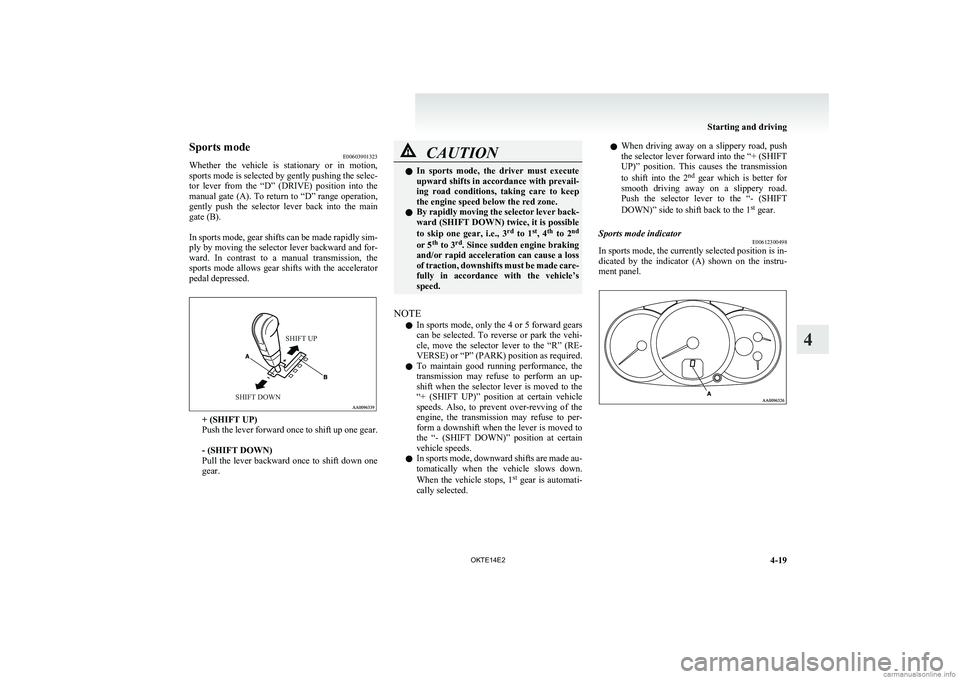
Sports modeE00603901323
Whether the vehicle is stationary or in motion,
sports mode is selected by gently pushing the selec-
tor lever from the “D” (DRIVE) position into the
manual gate (A). To return to “D” range operation,
gently push the selector lever back into the main
gate (B).
In sports mode, gear shifts can be made rapidly sim-
ply by moving the selector lever backward and for-
ward. In contrast to a manual transmission, the
sports mode allows gear shifts with the accelerator
pedal depressed.SHIFT UPSHIFT DOWN
+ (SHIFT UP)
Push the lever forward once to shift up one gear.
- (SHIFT DOWN)
Pull the lever backward once to shift down one
gear.
CAUTIONl In sports mode, the driver must execute
upward shifts in accordance with prevail-
ing road conditions, taking care to keep
the engine speed below the red zone.
l By rapidly moving the selector lever back-
ward (SHIFT DOWN) twice, it is possible
to skip one gear, i.e., 3 rd
to 1 st
, 4 th
to 2 nd
or 5 th
to 3 rd
. Since sudden engine braking
and/or rapid acceleration can cause a loss
of traction, downshifts must be made care-
fully in accordance with the vehicle’s
speed.
NOTE
l In sports mode, only the 4 or 5 forward gears
can be selected. To reverse or park the vehi-
cle, move the selector lever to the “R” (RE-
VERSE) or “P” (PARK) position as required.
l To maintain good running performance, the
transmission may refuse to perform an up-
shift when the selector lever is moved to the
“+ (SHIFT UP)” position at certain vehicle
speeds. Also, to prevent over-revving of the
engine, the transmission may refuse to per-
form a downshift when the lever is moved to
the “- (SHIFT DOWN)” position at certain
vehicle speeds.
l In sports mode, downward shifts are made au-
tomatically when the vehicle slows down.
When the vehicle stops, 1st
gear is automati-
cally selected.
l When driving away on a slippery road, push
the selector lever forward into the “+ (SHIFT
UP)” position. This causes the transmission
to shift into the 2 nd
gear which is better for
smooth driving away on a slippery road.
Push the selector lever to the “- (SHIFT
DOWN)” side to shift back to the 1 st
gear.Sports mode indicator
E00612300498
In sports mode, the currently selected position is in-
dicated by the indicator (A) shown on the instru-
ment panel.
Starting and driving
4-19
OKTE14E2
4
Page 144 of 362
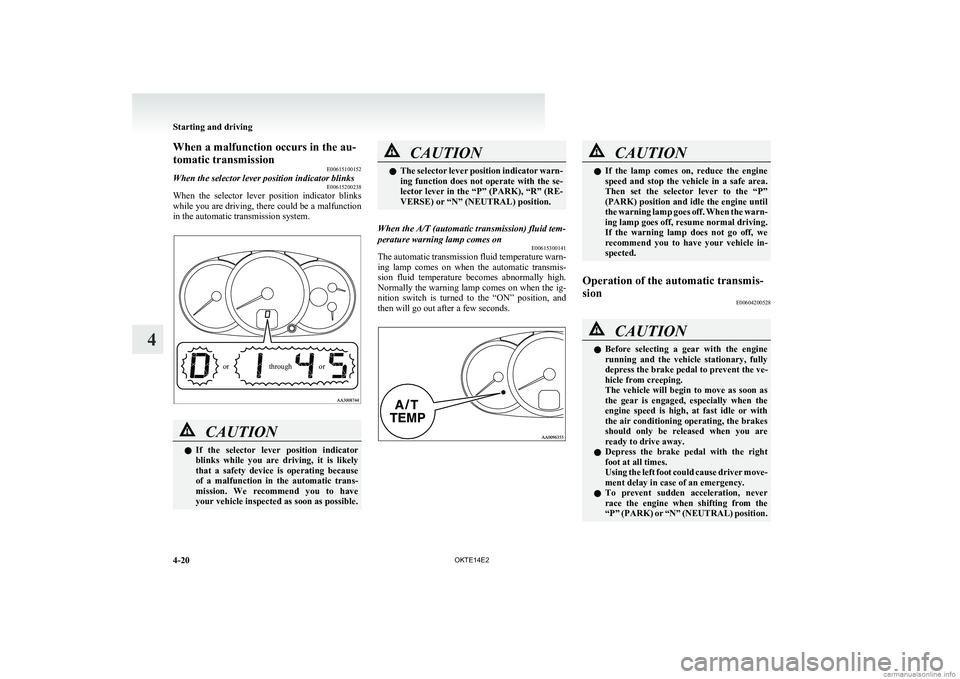
When a malfunction occurs in the au-
tomatic transmission E00615100152When the selector lever position indicator blinksE00615200238
When the selector lever position indicator blinks
while you are driving, there could be a malfunction
in the automatic transmission system.
orthroughor
CAUTIONl If the selector lever position indicator
blinks while you are driving, it is likely
that a safety device is operating because
of a malfunction in the automatic trans-
mission. We recommend you to have
your vehicle inspected as soon as possible.CAUTIONl The selector lever position indicator warn-
ing function does not operate with the se-
lector lever in the “P” (PARK), “R” (RE-
VERSE) or “N” (NEUTRAL) position.When the A/T (automatic transmission) fluid tem-
perature warning lamp comes on E00615300141
The automatic transmission fluid temperature warn-
ing lamp comes on when the automatic transmis-
sion fluid temperature becomes abnormally high.
Normally the warning lamp comes on when the ig-
nition switch is turned to the “ON” position, and
then will go out after a few seconds.
CAUTIONl If the lamp comes on, reduce the engine
speed and stop the vehicle in a safe area.
Then set the selector lever to the “P”
(PARK) position and idle the engine until
the warning lamp goes off. When the warn-
ing lamp goes off, resume normal driving.
If the warning lamp does not go off, we
recommend you to have your vehicle in-
spected.Operation of the automatic transmis-
sion E00604200528CAUTIONlBefore selecting a gear with the engine
running and the vehicle stationary, fully
depress the brake pedal to prevent the ve-
hicle from creeping.
The vehicle will begin to move as soon as
the gear is engaged, especially when the
engine speed is high, at fast idle or with
the air conditioning operating, the brakes
should only be released when you are
ready to drive away.
l Depress the brake pedal with the right
foot at all times.
Using the left foot could cause driver move-
ment delay in case of an emergency.
l To prevent sudden acceleration, never
race the engine when shifting from the
“P” (PARK) or “N” (NEUTRAL) position.
Starting and driving
4-20 OKTE14E2
4
Page 145 of 362
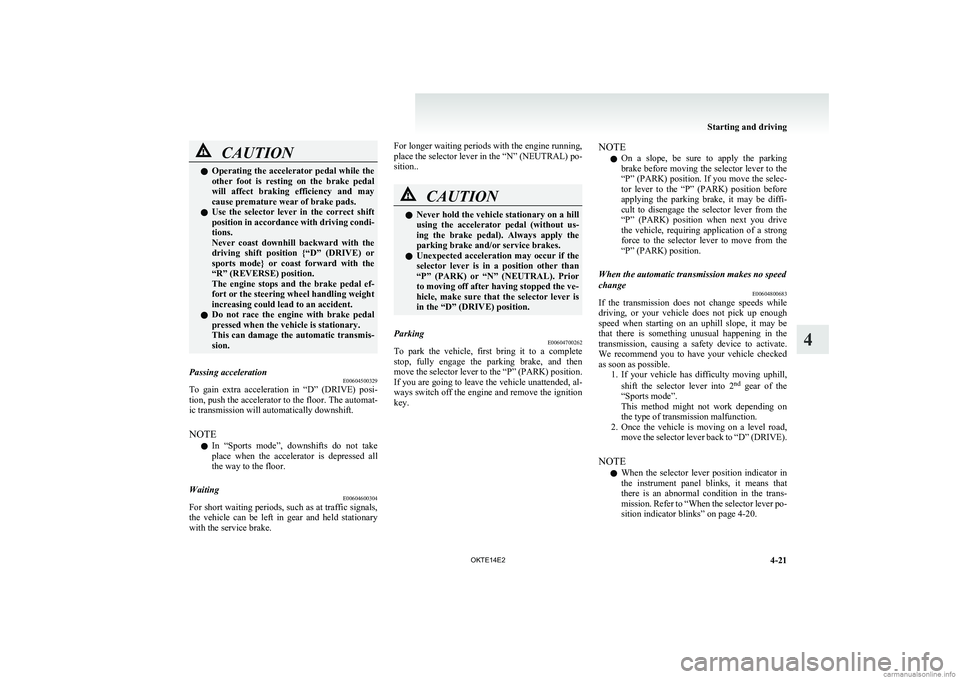
CAUTIONlOperating the accelerator pedal while the
other foot is resting on the brake pedal
will affect braking efficiency and may
cause premature wear of brake pads.
l Use the selector lever in the correct shift
position in accordance with driving condi-
tions.
Never coast downhill backward with the
driving shift position {“D” (DRIVE) or
sports mode} or coast forward with the
“R” (REVERSE) position.
The engine stops and the brake pedal ef-
fort or the steering wheel handling weight
increasing could lead to an accident.
l Do not race the engine with brake pedal
pressed when the vehicle is stationary.
This can damage the automatic transmis-
sion.Passing acceleration E00604500329
To gain extra acceleration in “D” (DRIVE) posi-
tion, push the accelerator to the floor. The automat-
ic transmission will automatically downshift.
NOTE l In “Sports mode”, downshifts do not take
place when the accelerator is depressed all
the way to the floor.
Waiting E00604600304
For short waiting periods, such as at traffic signals,
the vehicle can be left in gear and held stationary
with the service brake.
For longer waiting periods with the engine running,
place the selector lever in the “N” (NEUTRAL) po-
sition..CAUTIONl Never hold the vehicle stationary on a hill
using the accelerator pedal (without us-
ing the brake pedal). Always apply the
parking brake and/or service brakes.
l Unexpected acceleration may occur if the
selector lever is in a position other than
“P” (PARK) or “N” (NEUTRAL). Prior
to moving off after having stopped the ve-
hicle, make sure that the selector lever is
in the “D” (DRIVE) position.Parking E00604700262
To park the vehicle, first bring it to a complete
stop, fully engage the parking brake, and then
move the selector lever to the “P” (PARK) position.
If you are going to leave the vehicle unattended, al-
ways switch off the engine and remove the ignition
key.
NOTE
l On a slope, be sure to apply the parking
brake before moving the selector lever to the
“P” (PARK) position. If you move the selec-
tor lever to the “P” (PARK) position before
applying the parking brake, it may be diffi-
cult to disengage the selector lever from the
“P” (PARK) position when next you drive
the vehicle, requiring application of a strong
force to the selector lever to move from the
“P” (PARK) position.When the automatic transmission makes no speed
change E00604800683
If the transmission does not change speeds while
driving, or your vehicle does not pick up enough
speed when starting on an uphill slope, it may be
that there is something unusual happening in the
transmission, causing a safety device to activate.
We recommend you to have your vehicle checked
as soon as possible. 1.If your vehicle has difficulty moving uphill,
shift the selector lever into 2 nd
gear of the
“Sports mode”.
This method might not work depending on
the type of transmission malfunction.
2. Once the vehicle is moving on a level road,
move the selector lever back to “D” (DRIVE).
NOTE l When the selector lever position indicator in
the instrument panel blinks, it means that
there is an abnormal condition in the trans-
mission. Refer to “When the selector lever po-
sition indicator blinks” on page 4-20.
Starting and driving
4-21
OKTE14E2
4
Page 147 of 362
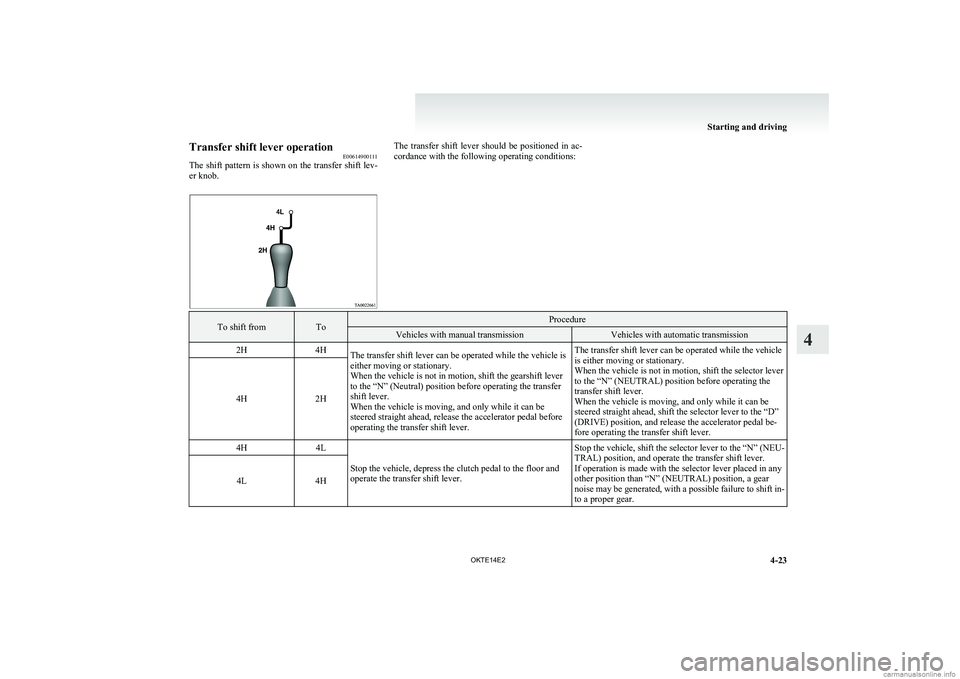
Transfer shift lever operationE00614900111
The shift pattern is shown on the transfer shift lev-
er knob.The transfer shift lever should be positioned in ac-
cordance with the following operating conditions:To shift fromToProcedureVehicles with manual transmissionVehicles with automatic transmission2H4HThe transfer shift lever can be operated while the vehicle is
either moving or stationary.
When the vehicle is not in motion, shift the gearshift lever
to the “N” (Neutral) position before operating the transfer
shift lever.
When the vehicle is moving, and only while it can be
steered straight ahead, release the accelerator pedal before
operating the transfer shift lever.The transfer shift lever can be operated while the vehicle
is either moving or stationary.
When the vehicle is not in motion, shift the selector lever
to the “N” (NEUTRAL) position before operating the
transfer shift lever.
When the vehicle is moving, and only while it can be
steered straight ahead, shift the selector lever to the “D”
(DRIVE) position, and release the accelerator pedal be-
fore operating the transfer shift lever.
4H2H
4H4L
Stop the vehicle, depress the clutch pedal to the floor and
operate the transfer shift lever.
Stop the vehicle, shift the selector lever to the “N” (NEU-
TRAL) position, and operate the transfer shift lever.
If operation is made with the selector lever placed in any
other position than “N” (NEUTRAL) position, a gear
noise may be generated, with a possible failure to shift in-
to a proper gear.
4L4H
Starting and driving
4-23
OKTE14E2
4
Page 148 of 362

NOTEl Shifting of the transfer shift lever between
“2H” ↔ “4H” should only be done at speeds
below 100 km/h (62 mph).
l During driving, never attempt to shift from
“4H” to “4L”.
l When shifting from “2H” to “4H” in cold
weather while the vehicle is in motion, the
transmission gear may make some noise. In
cold weather, try to shift the gear while the
vehicle is stopped.
l There may be a case that the transfer shift lev-
er feels heavy when it is moved from “4H”
to “2H” with the steering wheel in turned po-
sition.
This is normal and not any indication of trou-
ble.CAUTIONl Do not operate the transfer shift lever
while the rear wheels of the vehicle are
slipping on snow or ice.2WD/4WD operation indication lamp E00615000122
When the ignition switch is in the “ON” position,
the 2WD/4WD operation indication lamp shows
the shifting condition. The 2WD/4WD operation in-
dication lamp illuminates at each transfer shift lev-
er position as follows:
“2H” ↔ “4H”
Transfer shift
lever position2WD/4WD operation indication lamp
2H
Transfer shift
lever position2WD/4WD operation indication lamp
Drive mode
switching in progress 4H
: Illuminate: Remain off
NOTE l When the transfer shift lever is shifted be-
tween 2H ↔ 4H, the 2WD/4WD operation in-
dication lamp does not switch to illuminate
or remain off while the selection is in proc-
ess. Take the following precautions when the
indication lamp remains on or off. •Keep the steering wheel in the straight
ahead position while making range selec-
tions. If you attempt to drive forward
with the steering wheel turned, gear rat-
tling may occur and the desired range
may not actually be selected.
Starting and driving
4-24 OKTE14E2
4
Page 149 of 362
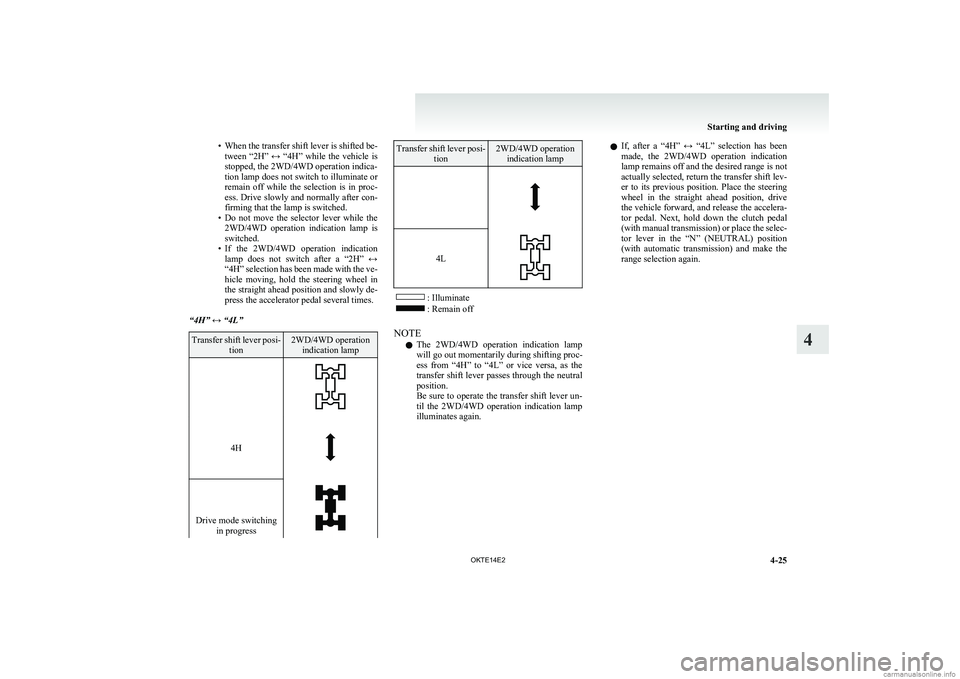
•When the transfer shift lever is shifted be-
tween “2H” ↔ “4H” while the vehicle is
stopped, the 2WD/4WD operation indica-
tion lamp does not switch to illuminate or
remain off while the selection is in proc-
ess. Drive slowly and normally after con-
firming that the lamp is switched.
• Do not move the selector lever while the
2WD/4WD operation indication lamp is
switched.
• If the 2WD/4WD operation indication
lamp does not switch after a “2H” ↔
“4H” selection has been made with the ve-
hicle moving, hold the steering wheel in
the straight ahead position and slowly de-
press the accelerator pedal several times.
“4H” ↔ “4L”Transfer shift lever posi- tion2WD/4WD operationindication lamp
4HDrive mode switching in progress
Transfer shift lever posi- tion2WD/4WD operationindication lamp
4L
: Illuminate: Remain off
NOTE l The 2WD/4WD operation indication lamp
will go out momentarily during shifting proc-
ess from “4H” to “4L” or vice versa, as the
transfer shift lever passes through the neutral
position.
Be sure to operate the transfer shift lever un-
til the 2WD/4WD operation indication lamp
illuminates again.
l If, after a “4H” ↔ “4L” selection has been
made, the 2WD/4WD operation indication
lamp remains off and the desired range is not
actually selected, return the transfer shift lev-
er to its previous position. Place the steering
wheel in the straight ahead position, drive
the vehicle forward, and release the accelera-
tor pedal. Next, hold down the clutch pedal
(with manual transmission) or place the selec-
tor lever in the “N” (NEUTRAL) position
(with automatic transmission) and make the
range selection again.
Starting and driving
4-25
OKTE14E2
4
Page 151 of 362

Transfer shift lever operationE00605900173
The shift pattern is shown on the transfer shift lev-
er knob.The transfer shift lever should be positioned in ac-
cordance with the following operating conditions:
: Not push down the transfer shift lever: Push down the transfer shift lever
To shift fromToProcedureVehicles with manual transmissionVehicles with automatic transmission2H4HThe transfer shift lever can be operated while the vehicle is
either moving or stationary.
When the vehicle is not in motion, shift the gearshift lever
to the “N” (Neutral) position before operating the transfer
shift lever.
When the vehicle is moving, and only while it can be
steered straight ahead, and release the accelerator pedal be-
fore operating the transfer shift lever.The transfer shift lever can be operated while the vehicle
is either moving or stationary.
When the vehicle is not in motion, shift the selector lever
to the “N” (NEUTRAL) position before operating the
transfer shift lever.
When the vehicle is moving, and only while it can be
steered straight ahead, shift the selector lever to the “D”
(DRIVE) position, and release the accelerator pedal be-
fore operating the transfer shift lever.4H2H or 4HLc
4HLc4H
4HLc4LLcStop the vehicle, depress the clutch pedal to the floor and
operate the transfer shift lever while keeping the transfer
shift lever pushed down.
Keep depressing the clutch pedal while the 2WD/4WD op-
eration indication lamp continues to blink.Stop the vehicle, shift the selector lever to the “N” (NEU-
TRAL) position, and operate the transfer shift lever
while keeping the transfer shift lever pushed down.
If operation is made with the selector lever placed in any
other position than “N” (NEUTRAL) position, a gear
noise may be generated, with a possible failure to shift in-
to a proper gear.
4LLc4HLcStarting and driving
4-27
OKTE14E2
4
Page 152 of 362
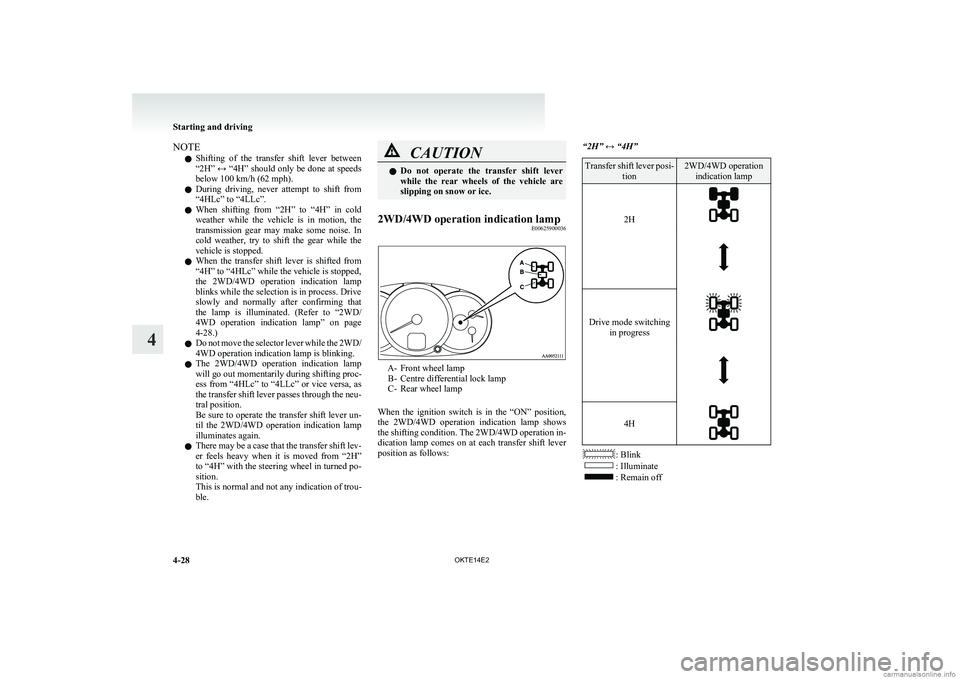
NOTEl Shifting of the transfer shift lever between
“2H” ↔ “4H” should only be done at speeds
below 100 km/h (62 mph).
l During driving, never attempt to shift from
“4HLc” to “4LLc”.
l When shifting from “2H” to “4H” in cold
weather while the vehicle is in motion, the
transmission gear may make some noise. In
cold weather, try to shift the gear while the
vehicle is stopped.
l When the transfer shift lever is shifted from
“4H” to “4HLc” while the vehicle is stopped,
the 2WD/4WD operation indication lamp
blinks while the selection is in process. Drive
slowly and normally after confirming that
the lamp is illuminated. (Refer to “2WD/
4WD operation indication lamp” on page
4-28.)
l Do not move the selector lever while the 2WD/
4WD operation indication lamp is blinking.
l The 2WD/4WD operation indication lamp
will go out momentarily during shifting proc-
ess from “4HLc” to “4LLc” or vice versa, as
the transfer shift lever passes through the neu-
tral position.
Be sure to operate the transfer shift lever un-
til the 2WD/4WD operation indication lamp
illuminates again.
l There may be a case that the transfer shift lev-
er feels heavy when it is moved from “2H”
to “4H” with the steering wheel in turned po-
sition.
This is normal and not any indication of trou-
ble.CAUTIONl Do not operate the transfer shift lever
while the rear wheels of the vehicle are
slipping on snow or ice.2WD/4WD operation indication lamp E00625900036
A- Front wheel lamp
B- Centre differential lock lamp
C- Rear wheel lamp
When the ignition switch is in the “ON” position,
the 2WD/4WD operation indication lamp shows
the shifting condition. The 2WD/4WD operation in-
dication lamp comes on at each transfer shift lever
position as follows:
“2H” ↔ “4H”Transfer shift lever posi- tion2WD/4WD operationindication lamp
2H Drive mode switching in progress 4H
: Blink: Illuminate: Remain off
Starting and driving
4-28 OKTE14E2
4
Page 153 of 362
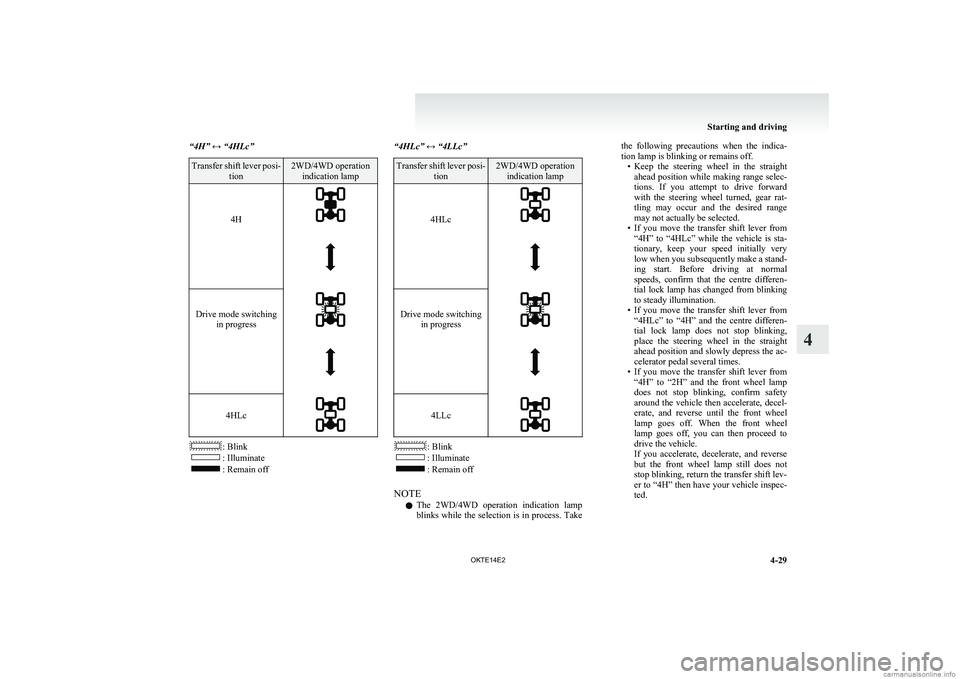
“4H” ↔ “4HLc”Transfer shift lever posi-tion2WD/4WD operationindication lamp
4H
Drive mode switching in progress
4HLc
: Blink: Illuminate: Remain off
“4HLc” ↔ “4LLc”Transfer shift lever posi- tion2WD/4WD operationindication lamp
4HLc
Drive mode switching in progress
4LLc
: Blink: Illuminate: Remain off
NOTE l The 2WD/4WD operation indication lamp
blinks while the selection is in process. Take
the following precautions when the indica-
tion lamp is blinking or remains off. •Keep the steering wheel in the straight
ahead position while making range selec-
tions. If you attempt to drive forward
with the steering wheel turned, gear rat-
tling may occur and the desired range
may not actually be selected.
• If you move the transfer shift lever from
“4H” to “4HLc” while the vehicle is sta-
tionary, keep your speed initially very
low when you subsequently make a stand-
ing start. Before driving at normal
speeds, confirm that the centre differen-
tial lock lamp has changed from blinking
to steady illumination.
• If you move the transfer shift lever from
“4HLc” to “4H” and the centre differen-
tial lock lamp does not stop blinking,
place the steering wheel in the straight
ahead position and slowly depress the ac-
celerator pedal several times.
• If you move the transfer shift lever from
“4H” to “2H” and the front wheel lamp
does not stop blinking, confirm safety
around the vehicle then accelerate, decel-
erate, and reverse until the front wheel
lamp goes off. When the front wheel
lamp goes off, you can then proceed to
drive the vehicle.
If you accelerate, decelerate, and reverse
but the front wheel lamp still does not
stop blinking, return the transfer shift lev-
er to “4H” then have your vehicle inspec-
ted.
Starting and driving
4-29
OKTE14E2
4
Page 154 of 362

lWhen you move the transfer shift lever from
“4H” to “4HLc”, there may be a slight delay
before the centre differential lock lamp illu-
minates.Rear differential lock* E00606200115
If one wheel starts to spin freely and the vehicle be-
comes stuck and cannot be freed even using 4-
wheel drive, the rear differential lock switch (A)
can be used to activate the rear differential lock for
extra traction.
Operating the rear differential lock
1.Move the transfer shift lever to “4L” or “4H”
position (easy select 4WD), “4LLc” or
“4HLc” position (super select 4WD).
2. To activate the rear differential lock, press
the rear differential lock switch (1).
3. To deactivate the rear differential lock, press
the rear differential lock switch (2).CAUTIONl Operate the rear differential lock switch
after the wheels are stopped. Operating
the switch with the wheels turning may
cause the vehicle to dart in unexpected di-
rections.
NOTE
l The rear differential lock does not operate
when the transfer shift lever is in “2H” posi-
tion (easy select 4WD), “2H” or “4H” posi-
tion (super select 4WD).
l When the rear differential is locked with the
transfer shift lever in “4L” or “4H” position
(easy select 4WD), “4LLc” or “4HLc” posi-
tion (super select 4WD) changing the shift
lever to “2H” position (easy select 4WD),
“2H” or “4H” position (super select 4WD)
makes the rear differential unlock automati-
cally.
Starting and driving
4-30 OKTE14E2
4